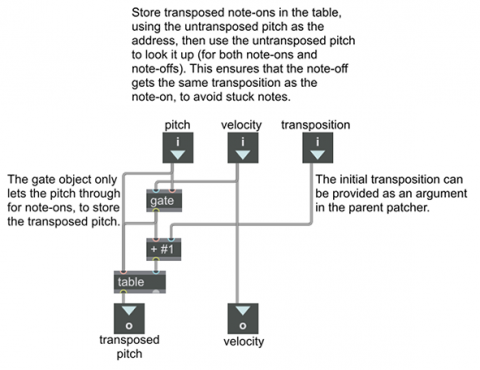Using table to transpose a MIDI note

Pitch transposition of MIDI notes is easy; you simply add (or subtract) some number of semitones to the pitch value. However, whenever you transpose a MIDI note-on message you have to make sure to transpose the corresponding note-off message by the same amount. Otherwise, the note will not get turned off and you'll get a "stuck" note that never ends. This can particularly be an issue when you're using an algorithmic process to transpose MIDI pitches; if the transposition value is changing, there's a risk that the note-off message will be transposed differently from the note-on.
This example provides an abstraction that takes care of that problem. It uses a table to store the transposed value of a midi note-on pitch, and then looks up that transposed pitch when the corresponding note-off message occurs. Notice the use of the gate obejct to direct traffic. It is opened and closed by the MIDI velocity value from the second inlet, which should (and normally will) arrive just before the pitch value. Because all note-ons have a positive velocity and all note-offs have a zero velocity, the gate will be open for note-ons and closed for note-offs. Thus, for each note-on, the pitch passes through the gate, gets transposed, and the transposed pitch is stored in the table, and then the original pitch value reads that transposition from the table and sends it out the outlet. For note-offs, though, the pitch does not go through the gate, so the previous transposed pitch is simply read out of the table again, turning off the transposed note.
You can use this abstraction in any patch, instead of simply using a + object. Notice that the + #1 argument will be replaced by whatever argument is typed in the transpose object box in the main patch, allowing you to specify an initial transposition value.